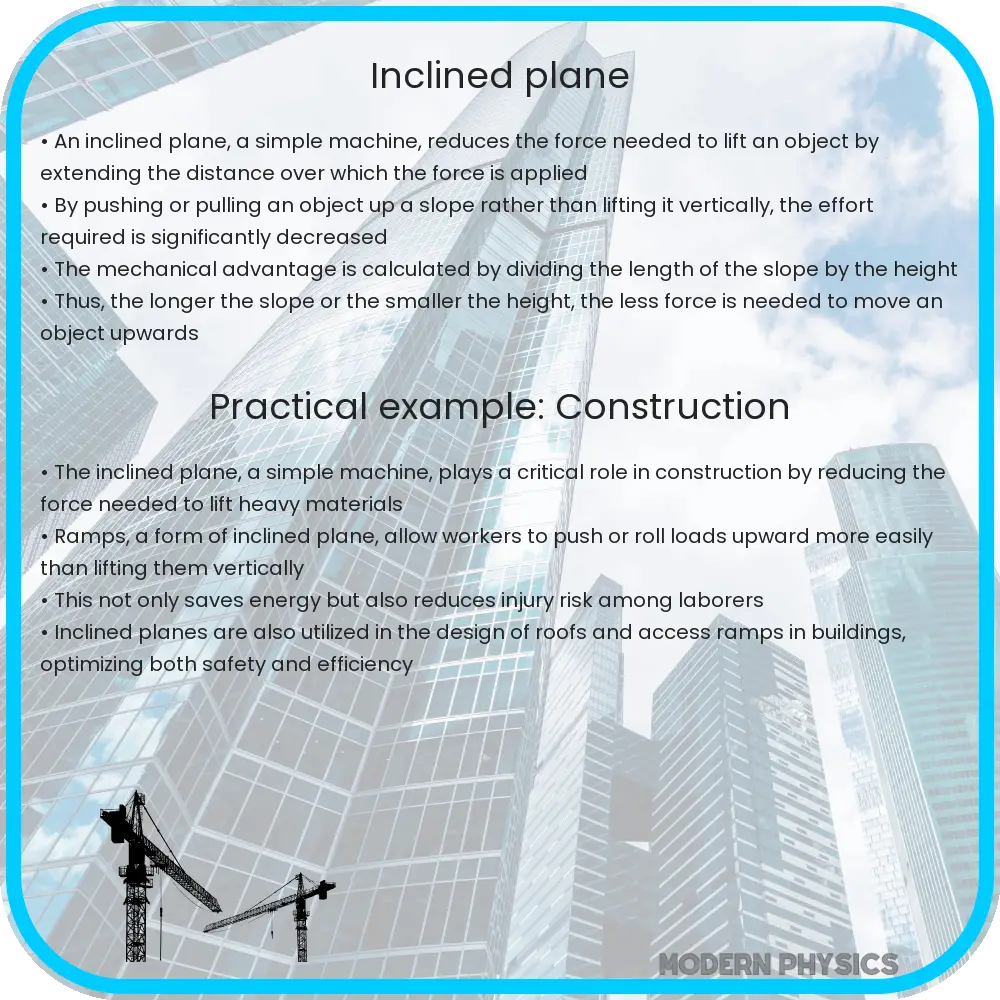Explore the dynamics of inclined planes, covering motion, force, efficiency, applications, and real-world challenges in this comprehensive guide.

Inclined Plane Dynamics: Understanding Motion, Force, and Efficiency
The study of inclined plane dynamics is a fundamental aspect of classical mechanics, offering profound insights into the principles of motion, force, and efficiency. An inclined plane, a flat surface tilted at an angle to the horizontal, serves as a simple yet powerful tool in understanding these concepts.
Basic Principles of Inclined Planes
When an object is placed on an inclined plane, it experiences a component of gravitational force pulling it downwards along the plane. This force can be dissected into two components: the force parallel to the plane (downhill force) and the force perpendicular to the plane (normal force). The parallel force is responsible for the object’s motion down the slope, while the normal force affects the frictional forces at play.
Motion on an Inclined Plane
The motion of an object on an inclined plane is governed by Newton’s Second Law of Motion, which states that the force acting on an object is equal to the mass of the object multiplied by its acceleration (F = ma). The acceleration of the object down the incline is determined by the net force acting along the slope, which is the gravitational force minus the force of friction. The equation for this is:
\[ a = \frac{{g \cdot \sin(\theta) – \mu \cdot g \cdot \cos(\theta)}}{{m}} \]
where \( a \) is acceleration, \( g \) is the acceleration due to gravity, \( \theta \) is the angle of the incline, \( \mu \) is the coefficient of friction, and \( m \) is the mass of the object.
Force Analysis on an Inclined Plane
The force analysis on an inclined plane is crucial for understanding the dynamics of objects in motion. The gravitational force acting on an object on an inclined plane is given by \( F_g = m \cdot g \). This force is resolved into two components:
- Parallel Component: \( F_{\text{parallel}} = m \cdot g \cdot \sin(\theta) \)
- Perpendicular Component: \( F_{\text{normal}} = m \cdot g \cdot \cos(\theta) \)
These components help in calculating the net force acting on the object, essential for determining motion and acceleration.
Efficiency of Inclined Planes
Inclined planes are often used to reduce the effort needed to raise a weight. The mechanical advantage (MA) of an inclined plane is the ratio of the weight of the object to the force needed to move the object up the plane. It is given by:
\[ MA = \frac{{\text{Length of Incline}}}{{\text{Height of Incline}}} \]
This formula demonstrates how inclined planes allow us to exert less force over a longer distance to accomplish work, highlighting their efficiency in various applications, from simple ramps to complex machinery.
Applications and Real-World Examples
Inclined planes find applications in various fields, from simple daily tasks to complex engineering projects. Common examples include ramps used in buildings for accessibility, loading docks in transportation, and even in large-scale constructions like bridges and dams. The principles of inclined plane dynamics also play a crucial role in understanding and designing roller coasters and other amusement park rides, where the balance of gravitational forces and motion creates thrilling experiences.
Calculating Work Done on an Inclined Plane
To further understand the efficiency of inclined planes, it’s important to consider the work done in moving an object up the plane. Work is defined as the force applied to an object times the distance over which the force is applied. On an inclined plane, the work done is given by:
\[ W = F_{\text{applied}} \cdot d \]
where \( W \) is work, \( F_{\text{applied}} \) is the force applied parallel to the incline, and \( d \) is the distance along the incline. This equation shows that by increasing the length of the incline (and thereby reducing the force needed), the same work can be done with less effort, which is the key to the efficiency of inclined planes.
Challenges and Considerations
Despite their advantages, inclined planes also present challenges. The primary concern is the friction between the object and the plane, which can vary significantly depending on the materials involved and the condition of the surfaces. Additionally, stability becomes a crucial factor, especially for steep inclines or heavy loads, requiring careful design and material selection.
Conclusion
In conclusion, the study of inclined plane dynamics offers invaluable insights into the principles of mechanics, particularly motion, force, and efficiency. By dissecting the forces at play and understanding the interplay between gravity, friction, and applied force, we can comprehend and predict the behavior of objects on inclined planes. This knowledge not only enriches our understanding of physical principles but also has practical applications in engineering, transportation, and everyday life. The inclined plane, a seemingly simple construct, thus stands as a testament to the elegance and utility of fundamental physics in our world.
